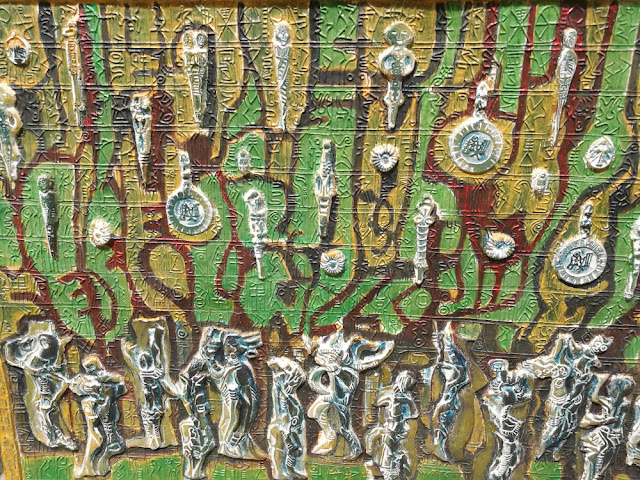 |
| Prof. Bruce Onobrakpeya talking about his plastocast works |
 |
| fiber glass coloured and painted |
Prof. is telling us that he has used different technics along his long career. He studied art at the ABU University in Zaria in the 1950's with some now famous professors like Ben Enwonwu. He studied with J. Grillo, Demas Nwoko and Uche Okeke.
The idea was to rediscover their african heritage using the western techniques they were taught at the University. This deviation soon earned them the name of "Zaria Rebels"
Bruce Onobrakpeya is now one of Nigeria’s most celebrated contemporary artists whose long career of creative leadership spans over 50 years. His international recognition as a “Living Human Treasure” by UNESCO, the Smithsonian National Museum of Africa Art in Washington DC, the Venice Biennale, and Nigeria’s highest honor, the prestigious Nigeria Creativity Award are a testimony to his place in the world of art.
 |
| "Nudes and protest" by Bruce Onobrakpeya |
His creativity is ever evolving in its medium and message: always modern yet deeply rooted in his indigenous culture. And what is truly unique to Bruce is what he has given back to the art community of Nigeria. He was saying that he is now coming back to painting. One of his famous painting is hung in the staircase of his studio. It is called " of Nudes and protest" which is seen as supporting the condition of women by feminist movements because it display female nudity and their role of pillar in the society.
In front of another installation, he was referring to the power of objects which may have no particular interest when taken separately but put together they would radiate a particular aesthetic. That is the logic for accumulating ritual objects in shrines.
 |
| Talking about the aesthetic of object accumulation in shrines |
Bruce Onobrakpeya was describing himself as an artist and also a teacher coming from a farmer's background. Prof's father was also a part time artist who worked during holidays, when he was not engaged in the farming season. He was then raised near Benin City. His family is originating from the Niger Delta. For many years he has run a residential art program called the Harmattan Workshops in his family home in the Delta. These workshops have inspired and challenged both seasoned and emerging artists. Artists from across the country and the world come together to share their creative energy! Theses workshops have inspired most of the great artists of Nigeria!
 |
| Bruce Onobrakpeya, plastocast with metal foil |
Pa Bruce Onobrakpeya is certainly one of the very best in the world for which Nigeria should be proud, This is a very good piece but could you kindly let us know which University made him a Professor and when?
ReplyDeletethis is what was shared with me by his family : Date for Honorary Doctoral Award to Bruce Onobrakpeya by Delta State University, Abraka, Delta State set for 22nd of July 2017. This is coming after almost 3 decades after his first award from the University of Ibadan.
DeleteAn artwork of Africans cultures, give deep meaning of believing the past wild lands and life.
ReplyDelete